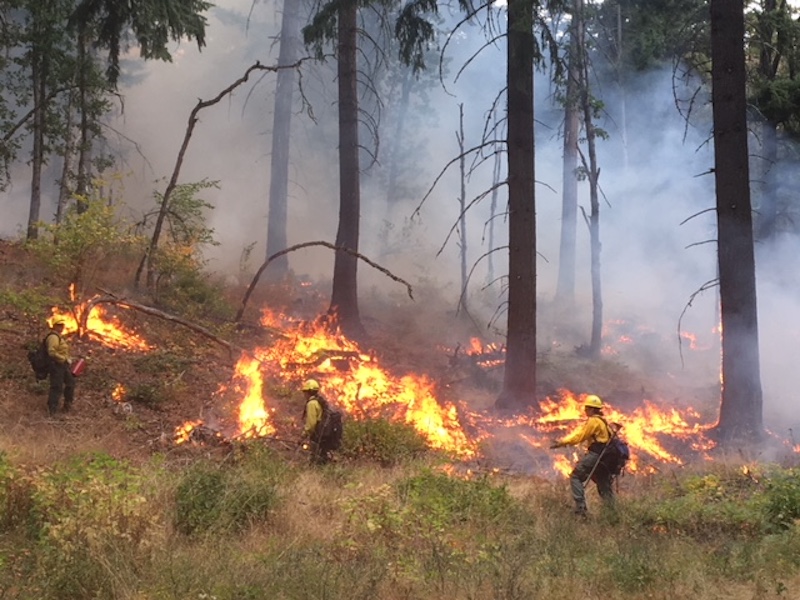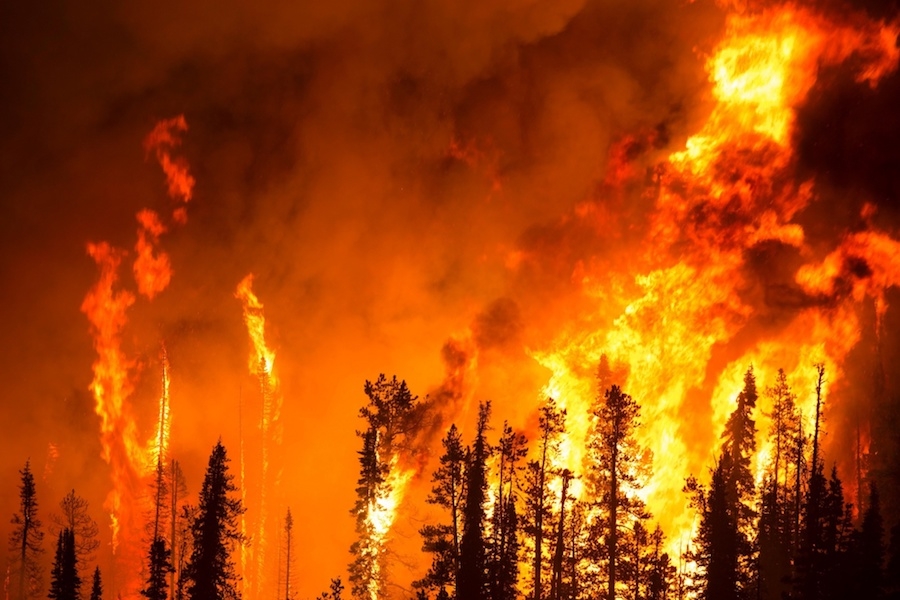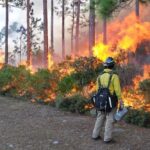Part three of a series of stories that investigates business solutions to climate change.
Above Multnomah Falls the scars of the 2017 Eagle Creek Fire are on display. Acres upon acres of charred Douglas fir cloak the slopes of the Columbia River Gorge.
Wildfire has become one of the most immediate and visible climate impacts in Oregon. In 2017 the state spent $38 million fighting large wildfires. Twenty-two million dollars of that was unexpected cost over what the Legislature budgeted for firefighting.
The secondary impacts rocked local businesses. Southern Oregon alone lost $51 million in tourism revenue because of fires, and suffered from some of the worst air quality in the nation.
“These are not your grandfather’s fires,” Sen. Ron Wyden told business leaders and politicians at the annual Oregon Leadership Summit in January. “They’re bigger. They’re hotter. It’s certain that climate change is contributing to our problems in the woods.”
Climate change has intensified fires by drying up forests, according to a report released this month by conservation nonprofit 1000 Friends of Oregon. Experts estimate that anthropogenic, or human-caused, climate change led to an additional 4.2 million hectares of forests burned in the western United States from 1984 to 2015, double the area that would have been expected to burn without climate change.
Businesses have called for a number of solutions. The ideas include more active management to prevent burns, changes to building materials and development practices, biofuels projects, and scaling up the work of forest collaboratives.
 Firefighters ignite a prescribed burn in the Columbia River Gorge. Credit: U.S. Forest Service
Firefighters ignite a prescribed burn in the Columbia River Gorge. Credit: U.S. Forest Service
At the summit, foresters, logging execs, legislators and environmentalists crowded into a small room. The urgency, and at times tension, was palpable. “It’s great to hear them talk about these issues,” said Rep. David Brock-Smith (R-Port Orford) early in the discussion. “But with all due respect they talked about it last year.”
The topic of the day was how to scale the work of the state’s 24 forest collaboratives. These local coalitions align loggers, environmentalists, business, government and other stakeholders in tenuous alliances for tough conversations about the future of the forest. The collaboratives meet regularly, and recommended policies to the Forest Service.
The collaboratives are poised to expand their work with an injection of funding this month under the 2018 farm bill. A provision in the legislation doubled the funding nationwide for these groups to $80 million.
Related Story: Four ways the farm bill will boost business in rural Oregon
Ed Keith, forester for Deschutes County and vice chair of the Deschutes Collaborative steering committee, says he isn’t sure how much funding his group will receive, but that the bill could potentially double their impact.
Formed in 2009, the Deschutes Collaborative has targeted fire through preventative measures, including thinning and prescribed burns. As part of its 18,000-acre West Bend Project in the Deschutes National Forest, technicians are cutting small-diameter trees and mowing underbrush to remove fuel for fires. The collaborative focuses on 250,000 acres near Bend to reduce risk to property and lives.
Additional funding is sorely needed. Even as the Forest Service fortifies areas, wildfire strikes back. The Pole Creek fire in 2012 burned the site of a project under planning. The Milli Fire in 2017 encroached upon an area that had already been treated.
“The scope and need of the work is pretty fast,” Keith says. “It’s kind of like a race against time.”
At the summit, Bend Mayor-elect Sally Russell called for additional funding for reducing the fuel load and managing smoke to protect the quality of life for Bend residents. “We simply don’t have enough money to do the work we could be doing,” she said.
Fire is part of the natural cycle of forests, but for most of the 20th century the Forest Service advanced a policy of stopping all burns. That allowed underbrush to accumulate and trees to grow in much denser stands than they normally do, building up a fuel base for large blazes.
Thinning and prescribed burns can remove the fuel, and also benefit the collaborative’s private-sector partners by furnishing raw material for timber mills. The downside of these practices are that they weaken the forest’s ability to store carbon.
Forests can take more than 15 years to get back to original carbon storage levels after even light thinning, according to an Oregon Global Warming Commission report just released. The authors advise that thinning projects must be balanced with efforts to store carbon.
Biofuel companies have found another way to profit from thinning. At its new plant in Lakeview, Colorado-based Red Rock Biofuels plans to harvest dead wood from the Fremont-Winema National Forest and private lands, and process it into jet fuel. A smaller company, Oregon Torrefaction, is working on a similar biofuels partnership near John Day with Ochoco Lumber.
Some landowners have taken matters into their own hands. Scott Campbell, owner of Silvies Ranch near Burns, employs herds of goats to thin his Ponderosa Pine forests. Cattle eat small grasses, then goats come in later to tackle small trees. Campbell says the Forest Service contracts with California landowners to use goats for thinning in areas where steep slopes block heavy equipment. He says it’s a more natural and cost-effective approach. “It’s definitely not natural to have people with chainsaws,” he says. “And it’s too expensive.”
Related Story: Rural county stakes future on renewable energy
Efforts to reduce fuel loads, the 1000 Friends report noted, can have an unintended consequence: encouraging more development in or around forests. The economic pressures to build lucrative resorts or housing at the edge of wildfire-prone forestland are strong. Nationwide, 60% of new houses built in the past decade have been situated in the “wildland-urban interface,” the transition zone between forests and cities.
Oregon’s strict land-use laws prohibit this dangerous development at the scale seen in California or other states, but it does happen. Jackson County approved the second-highest number of forest dwellings in 2014 and 2015, according to the report, even though it has some of the highest wildfire risk in the state.
“Largely driven by the proliferation of new structures,” the report authors write, the firefighting budgets of federal wildland management agencies tripled in the past ten years. Most of that money goes to putting out fires after they start, instead of prevention. More than half of the Forest Service’s $3 billion wildfire budget is spent on firefighting, rather than thinning, prescribed burns or fireproofing buildings.
If developers can’t be convinced to stay away from prime forestland, they can at least make efforts to fireproof their structures. The public-private partnerships formed through the collaboratives have a role in encouraging this behavior.
At the Tree Farm subdivision near Bend, the Deschutes Collaborative worked with the developer to put in defensible space zones and fire-resistant materials. “If we’re going to build, how can we build smarter?” asks Keith.
Keith says scaling up the collaborative projects makes financial sense. It takes about the same amount of time to plan for a 100,000-acre project or a 20,000-acre project. The summit attendees seemed receptive to the idea of a larger collaborative structure for the entire state, but noted it would take an enormous amount of federal funding and unprecedented collaboration.
Wildfire has become the most visible image of climate change in the Pacific Northwest. At the summit, Greg Block, president of Sustainable Northwest, called it “the issue that broke through the background noise.”
Yet it’s also one of the most intractable problems. “It’s definitely helped to have the increased funding, but we’re not approaching the finish line,” says Keith.
Next in the series: solutions to the effects of ocean acidification on Oregon fisheries.
Past stories in this series:
Design with Nature: working wetlands, water quality trading and Willamette restoration
Oregon’s water infrastructure hasn’t been upgraded in 100 years. Some think it’s time to fix that.
Climate change dominates business leadership talks
To subscribe to Oregon Business, click here.







